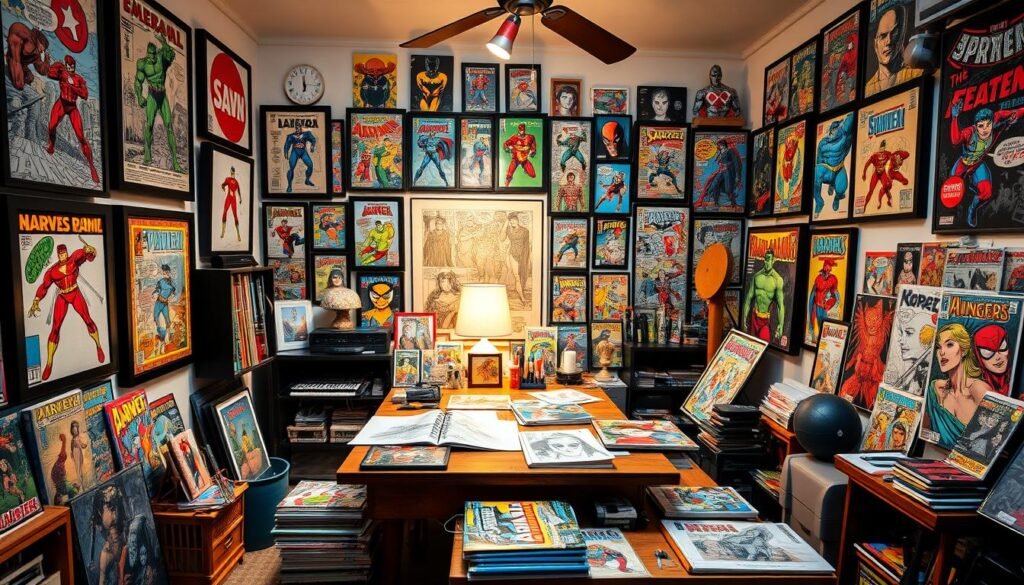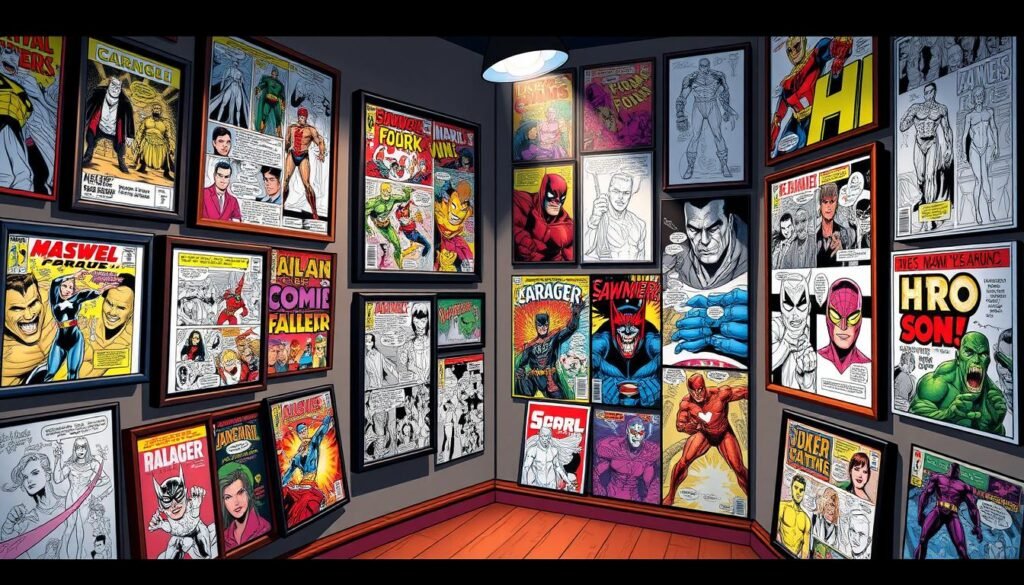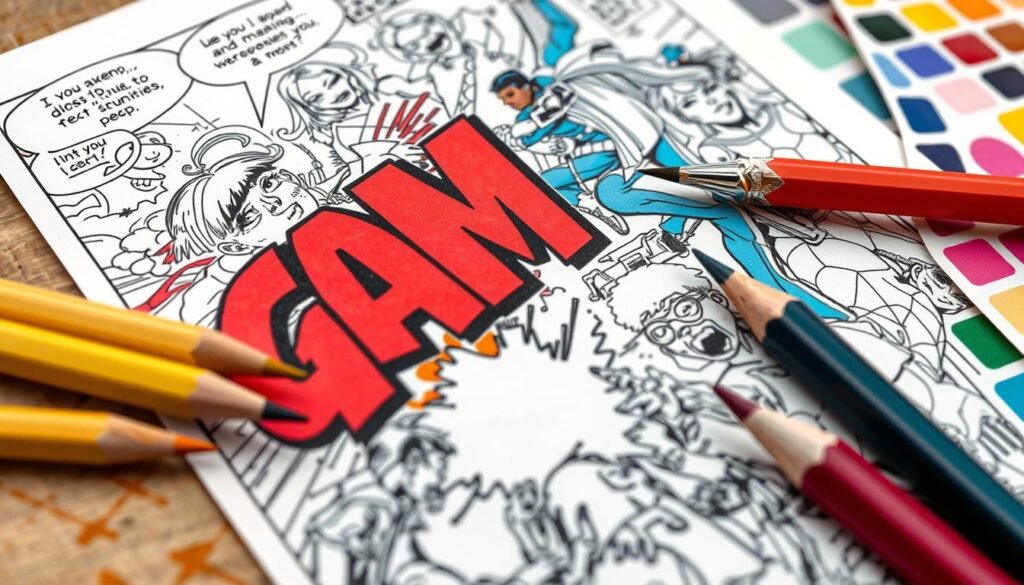I’ve always loved comic books and the amazing art they contain. The covers draw us in, and the panels take us to new worlds.
Recently, I saw an online auction with a Frank Quitely piece. The “FS: [QUITELY] Flex Mentallo #1 p. 07” got 72 views1. This shows how much people want his art. Other artists like Mike Mignola and Neal Adams also have fans, with their work getting lots of views too.
Collecting comic art is more than just buying pages. It’s about keeping the art of comics alive. This guide will help you start or grow your collection in the exciting world of comic art.
Key Takeaways
- Comic art includes original artwork from comic books, like covers and interior pages.
- The market for comic art has grown a lot, thanks to early collectors.
- Collectors often focus on specific artists, characters, or genres, showing the medium’s diversity.
- Demand for rare comic art pieces is high, as seen by the auction view counts.
- Many collectors aim to preserve the artistic legacy of comic books.
Understanding Comic Art and Its Appeal
As fans of illustrated storytelling admirers and comic convention attendees, we love comic art. It’s a world of creativity, from original pages to sketches. These pieces spark our imagination.
What Defines Comic Art?
Comic art is a team effort, with artists like pencillers and colorists2. It has grown from big “twice-up” sizes to the standard 11″x17″ in 19673. There are also daily strips and Sunday pages, each with its own story.
The Evolution of Comic Art
Comic art has changed a lot, moving from hand-lettering to computer lettering in the 1990s3. This change has made art more flexible and precise. Artists can now create amazing, detailed work.
We, as illustrated storytelling admirers and comic convention attendees, are amazed by comic art. It has evolved from superheroes to modern stories. This medium keeps inspiring us with its endless creativity.
Why We Collect Comic Art
We love collecting comic art for many reasons. It’s often because we have a strong emotional bond with the characters and stories. Many of us started collecting as kids, and it’s a hobby we’ve kept up for life.
The Emotional Connection
Collecting comic art is often a nostalgic journey. We find comfort and joy in revisiting the worlds we grew up with, and the act of collecting becomes a way to preserve and celebrate those cherished memories.4 This emotional connection makes each piece special and meaningful to us.
The Investment Opportunity
But there’s also a financial side to collecting comic art. Original comic art prices can range from a few hundred dollars to tens of thousands, and even exceed hundreds of thousands of dollars for the most sought-after pieces.4 This growth in value is a big reason why many of us collect. It’s not just about the money, though. It’s about the love for the art itself.
The comic art collecting community is growing fast. Sites like Comic Art Fans (CAF) help collectors share and trade their art4. Our passion for comic art is fueled by both the emotional connection and the chance to make a profit.

Whether we’re adding to an existing collection or starting fresh, the advice is the same. “Buy what you like in original art, and enjoy the pieces for their own sake, not just for speculation.”4 The real joy is in the personal connection and the thrill of finding new art that excites us.
“Original art collecting is an addiction, and collectors often feel the continuous need to acquire more pieces.” – GrailPages Original Comic Book Art and the Collectors4
The rarity and uniqueness of original comic art4 add to its allure. It’s not just about the value; it’s about preserving the art we love. As we grow our collections, we’re keeping the legacy of comic art alive.
Types of Comic Art We Can Collect
As fans of comic art, we have many choices to make our collections special. We can collect original artwork, limited edition prints, variant covers, and even custom sketches. The world of comic art is full of variety and excitement.
Original Art versus Prints
Original comic art, like pencils or inks, is very valuable. It shows the artist’s creative process and vision5. On the other hand, limited edition prints are more affordable. They have vibrant colors and details that bring the original to life5.
Variant Covers
Variant covers add to the fun of comic art collecting. They are different cover designs by various artists. Each one offers a unique take on favorite characters and stories6. You can find special edition or retailer-only variants, each with its own charm.
Sketches and Commissions
We can also collect sketches and custom pieces. Sketches show the artist’s first ideas, giving us a peek into their creative process6. Commissions are special pieces made just for you, adding a personal touch to your collection.
Collecting comic art lets us dive into the world of sequential art. Whether it’s a rare original, a striking variant, or a custom sketch, our collection shows our love for this art form.

How to Start Our Comic Art Collection
Starting our comic art collection is an exciting adventure. First, we need to set a budget and pick what we want to focus on7.
Setting a Budget
Decide how much you’re willing to spend. It could be a few hundred or a few thousand dollars. Remember, original art can be expensive. So, start with cheaper items like interior pages or sketches7.
Choosing Our Focus
Choose what you love most – maybe a favorite artist, character, or era. This helps you find valuable pieces and make smart buys. Going to comic book conventions and local stores can also help you meet other collectors and find new artists7.
Collecting comic art is more than just investing. It’s about the emotional connection we feel with the art. As we grow our collection, let’s enjoy the search and the pride of creating a personal gallery that shows our unique tastes8.
By setting a budget, focusing on what we love, and joining the comic art community, we start a fulfilling journey. This journey will deepen our appreciation for the art and stories that make comic art so special9.
Where to Find Comic Art
As fans of comic convention attendees and the comic fandom community, we have many places to find comic art. You can check out traditional comic book stores or online marketplaces. The world of comic art is vast and always changing.
Comic Book Stores
Comic book stores are a favorite spot for fans. They offer original comic art and prints. These stores help both new and experienced artists show their work10.
Online Marketplaces
The internet has changed how we find comic art. Sites like eBay and ComicLink are full of original art, sketches, and rare prints1011.
Conventions and Art Shows
Conventions and art shows are key for comic art lovers. Events like Comic-Con International in San Diego are perfect for meeting artists and finding unique art10.

Local art shows also showcase comic art. They offer a chance to meet artists and grow your collection10.
Whether you like stores, online shopping, or conventions, there’s something for everyone. The world of comic art collecting is full of possibilities for fans to explore and collect1011.
Evaluating Comic Art Quality
As comic artist following and illustrated storytelling admirers, we know how key it is to check the quality of our comic art. This ensures we get real and well-kept pieces. It also helps us make smart choices when growing our collections.
Understanding Grading Systems
Comic art grading looks at paper quality, ink clarity, and how well it’s kept12. The best pieces have top-notch paper, bright inks, and little wear. Knowing these systems helps us spot the real value and state of the art we want.
Identifying Authenticity
It’s vital to check if comic art is real to keep our collections true13. We can do this by digging into its history, talking to experts, and looking closely for any fake marks. Knowing where a piece comes from gives us peace of mind that it’s genuine.
Learning to judge comic art quality lets us create a collection that’s both meaningful and valuable1213. This skill helps us pick pieces that speak to us. It lets us enjoy the art we love for many years.

Caring for Our Comic Art Collection
As comic art fans and sequential art lovers, keeping our art in top shape is key14. Most comic books were made to be thrown away, not kept14. They’re made of wood pulp paper, which turns yellow and fades over time14. Many collectors store their comics in damp places, making it harder to keep them safe.
Proper Display Techniques
Displaying our comic art right is important14. We use comic grading to check the condition of old comics14. Different bags can affect our comics, with some causing damage or fading14.
To avoid damage, we should use UV-protective glass and frame our art carefully. We should handle it with clean, dry hands or cotton gloves to keep it safe.
Preserving Artwork
Storing our comic art right is also vital. We should keep it in acid-free materials and away from sunlight and extreme temperatures14. Regular checks help spot and fix any problems early, keeping our collection in great shape.
By following these steps, we can enjoy and protect our comic art. We can share it with future fans and artists.

| Preservation Technique | Benefits |
|---|---|
| UV-Protective Glass | Shields artwork from harmful UV rays, preventing fading and discoloration. |
| Acid-Free Materials | Prevents deterioration of paper and ink over time. |
| Temperature and Humidity Control | Maintains the optimal environment for long-term preservation. |
| Careful Handling | Minimizes the risk of physical damage to the artwork. |
“Composition is the intentional selection and arrangement of elements in a way that directs the viewer’s attention and evokes specific emotions, highlighting the importance of thoughtful choices in art.”15
By sticking to these tips, we can keep our comic art collection looking great. This way, we can enjoy and share these amazing works of sequential art for many years.
Building Connections in the Comic Art Community
Collecting comic art opens doors to a world of opportunities. Joining online forums and attending local meetups connects us with others who share our passion. We meet artists, experts, and fellow fans in a vibrant community16.
Joining Online Forums
Online forums and social media groups are great for discussing comic art. We learn about new artists, trends, and collecting tips. These digital spaces help us build friendships with people who love comics as much as we do16.
Attending Local Meetups
Local comic art events are also essential. They let us see rare artwork, learn from panels, and meet collectors and pros16. These experiences deepen our love for comic art and offer unique finds17.
Connecting online or in-person enriches our comic art journey. It gives us insights and opens doors to new discoveries. By joining the community, we find support, inspiration, and shared passion for this art form16.
| Comic Artist | Audience Reach | Key Projects |
|---|---|---|
| Ram Devineni | Over 26 million readers worldwide with 1,000 new stories17 | |
| Leorian Ricardo | Co-founder and president of Moro Studio in the Dominican Republic with over 10 years of experience17 |
“Comics can create new myths and ideas around globalization, using superhero comics to share democratic values across cultures.” – Ram Devineni17
Trends in Comic Art Collecting
As comic art enthusiasts and graphic novel lovers, we’re always excited to discover the latest trends. The world of comic art is constantly evolving18.
Emerging Artists to Watch
One trend we’ve noticed is the growing recognition of talented, up-and-coming comic artists. These creators are pushing the boundaries of the medium. They’re exploring new styles and capturing the imaginations of a wide audience18.
We’re keeping a close eye on award-winning artists and those who are gaining well-deserved attention in the industry.
Popular Themes and Genres
When it comes to themes and genres, we’re seeing a continued fascination with superhero stories, horror-themed comics, and science fiction narratives. These classic genres continue to captivate graphic novel lovers. At the same time, newer, independent comics are exploring diverse, thought-provoking concepts18.
| Trend | Emerging Highlights |
|---|---|
| Increased Interest in Silver Age Art | Collectors are seeking out iconic covers and key issues from the 1950s and 1960s, driving up prices for this era’s artwork. |
| Growing Popularity of Independent Comics | Unique and innovative storytelling from small publishers is capturing the attention of a new generation of readers. |
| Rise of Digital Art and NFTs | The digital age has introduced new frontiers for comic art, including the emergence of NFTs (Non-Fungible Tokens) as a way to own and trade digital artwork. |
As the comic art collecting landscape continues to evolve, we’re excited to see what the future holds. Keep an eye out for these trends and be on the lookout for the next generation of talented comic artists who are sure to captivate us all1819.
“The world of comic art is a constantly shifting landscape, where new voices and new ideas are constantly emerging to challenge and inspire us.”
Future of Comic Art Collecting
Technology is changing the world of comic art collecting fast20. Digital tools and platforms are making it easier to create, share, and buy comic art21. This opens up new areas for collectors to dive into21.
Online auctions and global marketplaces are making rare comic art more accessible to collectors everywhere20. As technology gets better, we might see new ways of telling stories in comics21. This could bring new chances for fans to collect and enjoy21.
The market for comic art is looking up, with rare pieces likely to increase in value2022. More people are interested in comic art because it’s easy to display and understand20. This could lead to more opportunities for collectors to invest in comic art22.
FAQ
What is comic art?
How has comic art evolved over time?
Why do we collect comic art?
What types of comic art can we collect?
How can we start collecting comic art?
Where can we find comic art?
How do we evaluate the quality of comic art?
How do we preserve our comic art collection?
How can we connect with other comic art collectors?
What are the current trends in comic art collecting?
How is technology impacting the future of comic art collecting?
Source Links
- Comic Art Classifieds, Original Comic Art and Sketches For Sale – https://www.comicartfans.com/classifieds.asp
- Comic Art Gallery of Michael Molinario at ComicArtFans.com – https://www.comicartfans.com/gallerydetail.asp?gcat=78756
- The AMAZING history of comic books & their art – https://99designs.com/blog/design-history-movements/history-of-comic-book-styles/
- The Art Of Collecting Original Art • Comic Book Daily – https://www.comicbookdaily.com/columns/tales-from-the-comicdenn/art-collecting-original-art/
- A Brief Guide to Comic Book Art Styles | Book Riot – https://bookriot.com/comic-book-art-styles/
- Comic Art Collecting Frequently Asked Questions – https://www.comicartfans.com/comic-art-collecting-glossary.asp
- Comicartfans :: Frequently Asked Questions (FAQ) – https://www.comicartfans.com/site-faq.asp
- Comic Art Collecting Frequently Asked Questions – https://www.comicartfans.com/comic-art-collecting-caring.asp
- Comicartfans :: Sign Up – https://www.comicartfans.com/reguser.asp
- Comic Art For Sale | Comicartfans – https://www.comicartfans.com/mainartforsale.asp
- Comic Art Fans :: New Comic Art – https://www.comicartfans.com/new_comic_art.asp
- The ABC’S of Comic Art – – https://comicartguide.com/comicartguide/the-abcs-of-comic-art/
- Is Investing In Comic Book Original Art A Good Idea? – https://medium.com/@joshualeto/is-investing-in-comic-book-original-art-a-good-idea-e064274fa17b
- The Art of Comic Book Conservation – https://preservation.library.harvard.edu/news/bagged-and-boarded-art-comic-book-conservation
- Composition For Comic Artists – https://www.howtodrawcomics.net/post/composition-for-comic-artists
- How To Build An Audience For Your Comic – https://updates.kickstarter.com/how-to-build-an-audience-for-your-comic/
- Storytelling and Community-Building Through Comics – Global Ties U.S. – https://www.globaltiesus.org/storytelling-and-community-building-through-comics/
- Comic Art Collecting Frequently Asked Questions – https://www.comicartfans.com/comic-art-collecting.asp
- Comic Art Collecting Frequently Asked Questions – https://www.comicartfans.com/comic-art-collecting-obtaining.asp
- 4 Factors Behind American Collectors’ Growing Interest In Original Comic Art – https://www.forbes.com/sites/adamrowe1/2020/02/15/4-factors-behind-american-collectors-growing-interest-in-original-comic-art/
- Mark McKenna, José Delbo and The Digital Future of Comic Book Art | MakersPlace Editorial – https://rare.makersplace.com/2020/12/09/mark-mckenna-jose-delbo-and-the-digital-future-of-comic-book-art/
- Investing in Original Comic Art – https://forum.comicsheatingup.net/t/investing-in-original-comic-art/7344